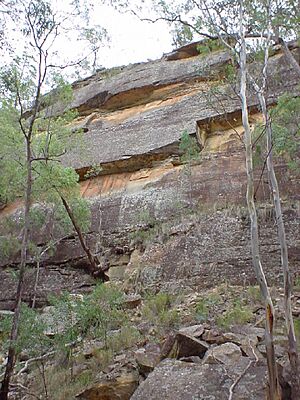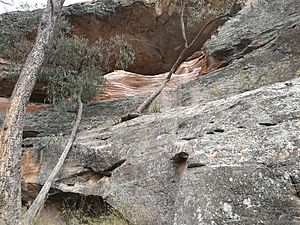Pilliga forest facts for kids
The Pilliga Scrub, also known as the State Forests of The Pilliga, is a huge forest area in central New South Wales, Australia. It covers about 3,000 square kilometers, which is like 300,000 football fields! It's the largest area of dry woodland in the state. You can find this forest near towns like Baradine and Narrabri, and villages such as Pilliga and Gwabegar.
Contents
History of the Pilliga Forest
A writer named Eric Rolls wrote a famous book about the Pilliga called A Million Wild Acres. In his book, he suggested that the forest used to be more open. He thought that after Europeans arrived, a type of tree called cypress pine grew much more thickly.
However, many scientists now disagree with this idea. They have looked at old records from the 1870s and found that the types of plants in the forest haven't changed as much as Eric Rolls thought. Even so, his book is still very important for understanding the history of this special area.
Exploring the Pilliga Environment
What is the Pilliga Made Of?
The ground in the Pilliga is mostly made of a type of rock called Pilliga sandstone. This sandstone is usually red or yellow. It's made up of about 75% quartz, which is a very hard mineral.
In the southern parts of the Pilliga, you can see sandstone cliffs and hills with basalt rock on top. Basalt is a dark, volcanic rock. In the north, there are flat areas made from dirt left behind by flooding creeks.
You might also find small, shallow lakes called gilgais. These lakes are usually dry. In the west, there are dry, sandy creeks that people sometimes call "sand monkeys." To the east, there's an old mountain range made of sandstone. You can see parts of it, like the sandstone cliffs around Gin's Leap.
Plants and Animals of the Pilliga
The Pilliga forest is home to at least 900 different kinds of plants! Some parts of the forest, especially in the west, have a lot of cypress-pine trees. But there are many other types of plants too.
You'll also find smaller trees like she-oaks. Taller trees, called eucalypts, grow all over the forest.
The Pilliga Nature Reserve is full of animals. There are at least 36 types of native mammals and nine types that were brought in by people. You can also find 50 kinds of reptiles and at least 15 types of frogs. Some of the special animals living here include Squirrel Gliders, Koalas, Rufous Bettongs, and the rare Pilliga Mouse.
Amazing Birds of the Pilliga
A large area of land, including the Pilliga forest and the nearby Warrumbungle National Park, is known as an Important Bird Area (IBA). This means it's a very important place for birds. It's home to groups of Painted Honeyeaters and Diamond Firetails.
Sometimes, you might even spot endangered birds like the Swift Parrot and the Regent Honeyeater. Birds that are near threatened, like the Bush Stone-curlew, are also seen here.
Other woodland birds that live in good numbers in the Pilliga include Barking Owls, Glossy Black-Cockatoos, Grey-crowned Babblers, Speckled Warblers, Brown Treecreepers, Hooded Robins, and Turquoise Parrots.
Fires and the Forest's Life Cycle
Fire is a very important part of the ecology of the Pilliga forest. Many plants actually need fire to grow back and reproduce. Sometimes, these fires can be extremely hot and spread very quickly. They can threaten nearby homes and destroy entire ecosystems.
If fires happen too often, like less than 15 years apart, it can cause a loss of different plants and animals. The size of the Pilliga bushfires is connected to something called the El Nino weather pattern. During El Nino years, which are usually dry, the fires tend to be much more severe.
For example, in 1997, a huge fire burned about 1,435 square kilometers of the forest. In 2006, after a very dry winter and spring, several large fires started. One of them, the Pilliga 4 Fire, burned 740 square kilometers in just one day!
Visiting the Pilliga Forest
There are many roads throughout the Pilliga forest. Many of these used to be roads for the logging industry. People used to cut down cypress pine and ironbark trees here. However, in 2005, the NSW government decided to protect most of the forest to help save its environment.
The Pilliga has many cool places to visit, including:
- Sculptures in the Scrub: These are a series of amazing sculptures placed along the beautiful Dandry Gorge.
- Salt Caves: These are shallow sandstone caves located in the middle of the Pilliga.
- Dandry Creek Gorge: A stunning sandstone cliff area in the southern part of the Pilliga.
- Pilliga Pottery: A unique pottery studio located off the highway, north of Coonabarabran.
- Bird-watching: With so many bird species, the Pilliga is a great place for bird-watching. You can get information leaflets from the Baradine Visitor's Centre.
Images for kids












